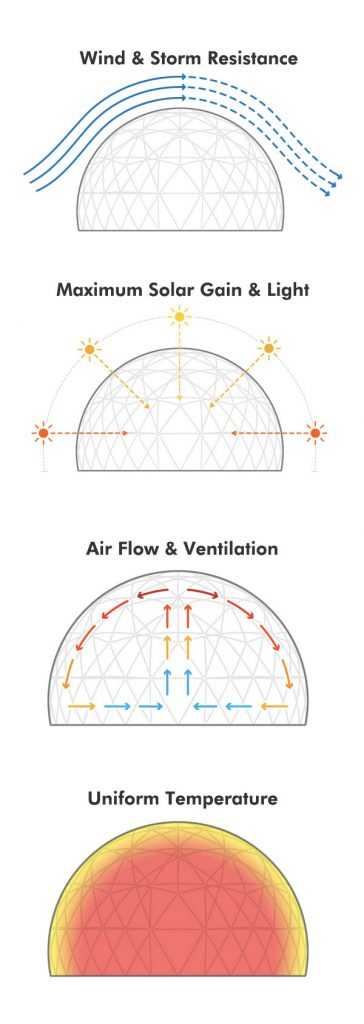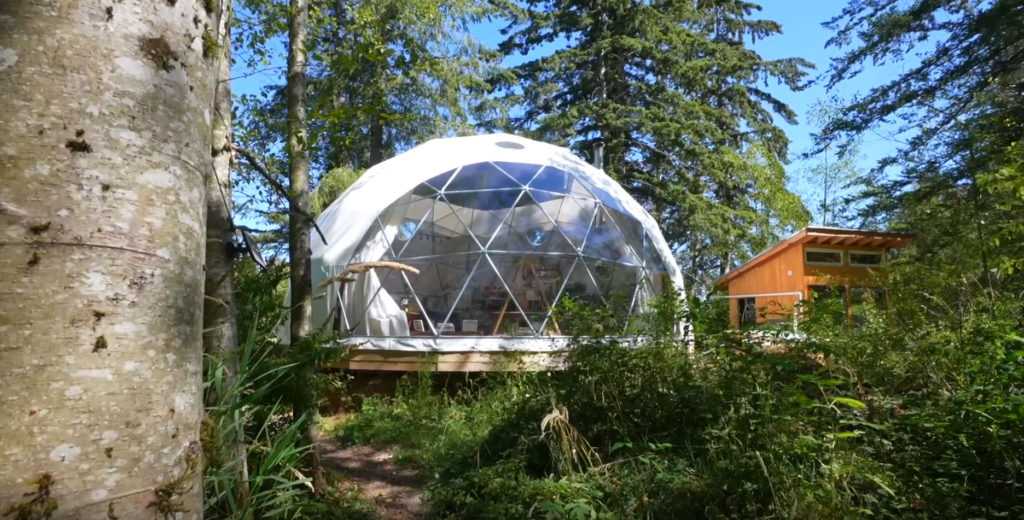In the ever expanding realm of tiny houses, modular homes and alternative living structures, prefabricated domes and yurts stand out as architectural wonders that capture the imagination of those seeking a harmonious blend of nature along with many of those creature comforts that we’ve all grown accustomed to enjoying. Rooted in ancient nomadic traditions, yet adapted to modern living, these freestanding, portable structures offer a refreshing, Zen-like departure from conventional homes.

Whether you’re simply curious about alt-housing options for your backyard studio, vacation retreat or for tiny house off-grid living, we invite you to join us as we delve into the allure that the world of domes and yurts holds. We’ll uncover the strengths and considerations that make domes and yurts popular choices among many nature enthusiasts, adventurers and eco-conscious builders around the globe.
Tent Types: Comparing Domes, Yurts and Camping Tents
Domes, yurts and camping tents appeal to those who share a kinship with nature and the outdoors. In order to weed out any confusion between a variety of canvas covered tent types, let’s take a closer look at some of the features that they have in common – as well as, what sets domes and yurts apart from camping tents.
What do domes and yurts have in common with camping tents? Domes and yurts are similar in that the exterior frame cover is typically constructed from durable canvas materials – most commonly used in rugged camping tents, e.g. bell tents.
Pop-up camping tents and their close cousin, bell tents are great shelter options because they’re inexpensive, lightweight and go up quickly. People inadvertently discover that there’s more to owning a canvas tent than it’s appealing shape, though. Purchasing the right canvas tent can be an investment that lasts a lifetime with proper care and maintenance, so you will want to know what you’ll be using your tent for.
Historically, camping tents are used for back-packing, off-road expeditions and short camping trips, while bell tents offer a more luxurious, safari-like experience. Although, domes and yurts are lightweight, portable and easy-to-set-up, they weigh more than most camping tents; they come with a higher price tag; and, they require a bit more calculated planning and site prep.
That said, both domes and yurts are popular shelter options because they are available in easy to assemble DIY kits. Additionally, they are considered temporary structures – meaning that they can still be relocated or taken down and stored as needed.
Dome and yurt kits can go up in just about any terrain, landscape or climate and are often used as semi-permanent and even permanent housing solutions. Unlike camping tents that are only available in pre-set factory features and sizes, domes and yurts offer ergonomic sizes that can be customized with features to suit just about anyone’s lifestyle or budget. Typically, they serve the alternative housing market. For example, they have become increasingly popular as: tiny homes, backyard studios, glamping (glamorous camping) and digital nomad work-from-anywhere housing solutions, to name just a few.
What’s the Difference Between Domes and Yurts?
At Pacific Domes, we’re occasionally asked, what’s the difference between a dome and a yurt? Ultimately this leads to the question, “what’s the best investment, a dome or a yurt?
If you’ve landed on this blog post, chances are you may be wondering how domes stack up against the timeless elegance of yurts? With all due respect to our nomadic yurt-building ancestors, we love talking about our ecoliving dome homes, their geodesic-engineered strength, portability and energy-efficiency credentials. That said, our goal is to provide you with relevant information, such as features and functionality, that will allow you to form your own conclusions.
To help you decide which choice is best for you, let’s explore what makes domes and yurts unique by making side-by-side comparisons between their features and benefits. After weighing in on some unique comparisons, we’re confident you’ll agree that our domes are by far the most efficient human shelter around.
Domes vs. Yurts: Key Takeaways
Ecoliving Domes
• Withstand arctic conditions – heavy snows & high winds
• Withstand hurricanes & earthquakes
• Geodesic steel frame & UV/Mildew resistant natural fiber canvas or, architectural fabric
Yurts
• Can collapse under heavy snow (Source: http://bit.ly/2oznRem)
• Sustained winds require additional bracing and tethering (*see below)
• Structural material made of wood with canvas/ vinyl covers (Source: http://bit.ly/2oz8RNr)
Let’s weigh-in on what Asha – Pacific Domes Founder, has to say…
The Geodesic Dome is the strongest structure known to man! Research teams use our domes for polar expeditions because they pack down for transport – and, handle extreme winds and snow.
Before I made and lived in my first dome, I made and lived in tipis and yurts. I discovered that there’s a huge difference between them all – that, you won’t notice until you live in them full time.
Tipi’s require skill to control the temperature, even if you install a woodstove! Yurts have a crisscross lattice, and although some don’t mind it, it is distracting to your view. As you can see, I love windows!
While it’s true that Tipi poles can be made in a couple of days by thinning the forest, you can’t just throw them in your car when you want to move. The yurt framework is even more bulky and hard to pack.
Other than portability, the dome out does them both for managing high winds. Our clients in high wind areas ordered domes after their yurts had blown over. *They also, learned that using wind wires were unsafe – people trip over them in the night. A dome is freestanding and doesn’t require any wind wires!
Geodesic Dome Homes
Domes have gained worldwide popularity in non-traditional housing markets, such as eco-tourism, glamping, and even disaster relief efforts. Due to their portability, economical building costs and sustainability, domes solve many unaddressed ecologic and economic challenges in traditional building methods and materials.
Domes are suited to all types of terrains. They are fully deployable and can be erected in hours with simple hand ratcheting tools. Because they are considered temporary shelters – in that they can be taken down when no longer needed – this often simplifies or bypasses building codes.
The spacious dome interior offers limitless possibilities for creativity. Its circular design encloses the greatest volume of interior space with the least amount of surface area.
“There are continuous reports of the geodesic dome being the only building left standing after a hurricane.” — Pacific Domes Inc.

Concepts Behind the Dome According to the Buckminster Fuller Institute
Domes came into vogue in the ‘60s with Buckminster Fuller, father of the modern geodesic dome. Fuller received many awards throughout his life-long career and was awarded the American Institute of Architects’ Gold Medal for inventing the strongest structure known to man.
Fuller demonstrated the difference in strength between a rectangle and a triangle by applying pressure to both structures. The triangle proved to be twice as strong and remained rigid while the unstable rectangle collapsed.
He also discovered that a sphere created from triangles, had unparalleled strength. This led to the “doing more with less” principle and the geodesic dome.
Fuller reintroduced the idea that when the dome’s diameter is doubled it will quadruple its square footage and produce eight times its volume, a dramatic increase in space over a yurt. A dome encloses the largest volume of interior space with the least amount of surface area, thus saving on materials and cost.
A dome’s structure is one of the most efficient interior spaces because air and energy circulate without obstruction. This enables natural heating and cooling.

Domes Are Energy Efficient
Geodesic dome shelters have been built all around the world in various climates, proving to be the most efficient human shelter one can find. Specifically, domes are more energy efficient than yurts for the following reasons:
- Its decreased surface area requires less building materials
- Exposure to cold in winter and heat in summer is decreased, due to less surface area per unit of volume.
- The concave interior creates a natural airflow allowing hot or cool air to flow evenly throughout the dome with the help of return air ducts.
- Extreme wind turbulence is lessened because winds contributing to heat loss flow evenly around the dome.
- It acts like a giant downward reflector that concentrates interior heat, preventing radiant heat loss.
- Dome studies, comparing same-size traditional homes, have shown a 30% energy savings.
In conclusion, Pacific Domes hopes you’ve enjoyed learning more about what makes domes and yurts unique. We invite you to explore our Dome Home Pricing Guide to help you along your purchasing journey.
Get Pacific Domes Pricing Guide

